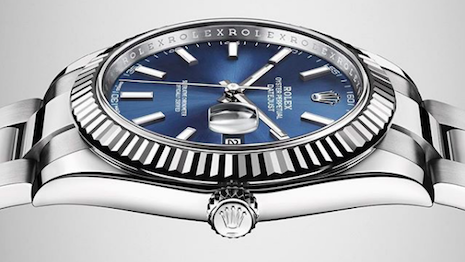- About
- Subscribe Now
- New York,
May 4, 2018

 It's Rolex's time; Image credit; Rolex.
It's Rolex's time; Image credit; Rolex.
Watch brands are making small strides towards modernization, but much of their businesses remain traditional, leading them to miss out on influencer-driven marketing campaigns during Baselworld this year.
Baselworld is a more-than-100-year-old tradeshow for fine watches and jewelry, and while brands that present are some of the world’s most prestigious houses, their marketing tactics are falling behind. According to a new report from Launchmetrics, these watch manufacturers believed they were engaging influencers during Baselworld, but the influencer voice was reported as the lowest media tracked.
“Something that was surprising was that 65 percent of brands surveyed said they engaged influencers for their Baselworld plans but however the influencer voice was reported as one of the lowest in our data rankings,” said Anaud Roy, chief strategy officer at Launchmetrics. “That said, the fact the voice was not a strong as traditional media or owned media for this audience isn't as surprising since influencers are traditionally used to create a connection with digital native consumers, Gen Y and Z, which for an event as Baselworld we know it's not a key objective for brands.”
Baselworld findings
Swiss watch brands are generally disinterested in the younger segments such as millennials and Gen Z, which is reflected in their lack of adoption to new marketing ways.
For Baselworld, brands surveyed by Launchmetrics were much more interested in traditional outlets and capturing older segments. Owned media was significantly successful in capturing this segment.
As more tradeshows, such as fashion week, become increasingly consumer facing, Baselworld holds onto its roots as a business-to-business event.
While this strategy works for now, this could be the watch industry’s downfall in the future as digital-savvy consumers grow older.
Launchmetric’s whitepaper on social impact during Baselworld showed that Rolex had the largest media impact value by far, at 2.4 million euros, or $2.8 million at current exchange.
Rolex also shared the most placements with 4,663, compared to Omega in second place at 3,079. The brand also saw the most value earned from Instagram and Facebook out of all the studied brands.
Longines had the least number of placements and did not make it into the top 10 of media impact value.
Theses brands are highly focused on media for Baseworld, as 40 percent noted they were targeting media during the event, 10 percent said consumers and 50 percent claimed both.
Product launches, brand awareness and new collections were at the forefront of watch brands’ minds during Baselworld, at 25 percent, 25 percent and 20 percent respectively in terms of objective.
Additional insight
As this year’s Baselworld came to a close, the theme of announcements from timepiece manufacturers seemed to reveal that the watch industry could have finally embraced the digital world.
After years of watchmakers refusing to accept the shift to ecommerce and digital, this year’s trade show in Switzerland indicates that the time has finally come. Hublot and Frederique Constant are a few of the heritage watch brands who innovated in smartwatches, while others such as Tag Heuer and Richemont bet big on ecommerce, but Baselworld’s significance might be shrinking due to the digital uprising (see more).
While social media and digital are duplicating brands’ product launches and announcements, the use of influencers was still missing and the watch industry’s future remains unclear.
According to the Federation of the Swiss Watch Industry’s monthly statistics, watch exports saw “timid” growth in December, but overall 2017 saw improvements.
During peak holiday shopping season, watch industry exports had weak growth in December despite a relatively low comparison base. In recent months the Swiss watch export statistics have been showing performance recovery, but the sector remains challenged overall (see more).
“Fashion, luxury and cosmetic brands are rushing to catch up with digital-savvy customer as most of the advertising spends are shifting away from traditional print media and towards social media, but depending on the product, target and market they need to be strategic with how they divide their marketing mix to address all possible customers, Generation Y and Z versus older generations,” Launchmetric’s Mr. Roy said. “Traditional media was still one of the main voices driving media impact value for this century-old event and is the perfect channel to connect with older generations while helping brands increase brand awareness and equity as well as help them discover new products.
“It is at the top of the influencer funnel and helps to cast the widest net,” he said. “Owned media also played a key role in driving media impact value during the event as it allows brands to further connect with their existing fan (customer) base and create a unique experience for them.
“It's consistent with the main brand goals during a product/collection launch and is a strong proponent of increasing share of wallet with these customers. Who is more likely to buy a Rolex than someone that already owns a Rolex?”
Share your thoughts. Click here